


The following are types of wasps, bees and insects commonly found throughout Wisconsin:
| Insect | Location | Nesting Habits | Diet | Rarity in Wisconsin | Do they sting? |
|---|---|---|---|---|---|
| European Paper Wasp | Europe, North America | Nests made of paper, typically found in trees or shrubs | Insects, nectar | Uncommon | Yes |
| Paper Wasp | North America | Nests made of paper, typically found in trees or shrubs | Insects, nectar | Common | Yes |
| Yellow Jacket | Worldwide | Underground nests or above-ground nests in trees or shrubs | Insects, fruit, nectar | Common | Yes |
| Mining Bee | Worldwide | Underground nests | Nectar, pollen | Common | No |
| Carpenter Bee | Worldwide | Nest in wood, often in abandoned carpenter bee nests | Nectar, pollen | Common | No |
| Mud Dauber | Worldwide | Nests made of mud, often found on walls or eaves of buildings | Insects, nectar | Uncommon | No |
| Bald Faced Hornet | North America | Nests made of paper, typically found in trees or shrubs | Insects, nectar | Common | Yes |
| Asian Beetle | Asia | Varies by species | Varies by species | Rare | No |
| Boxelder Bug | North America | Typically not social, do not build nests | Sap from boxelder trees | Common | No |
| Stink Bug | Worldwide | Typically not social, do not build nests | Plant material, occasionally insects | Common | No |
| Cluster Fly | Worldwide | Typically not social, do not build nests | Pollen, nectar | Common | No |
| Honey Bee | Worldwide | Nests made of wax, typically found in trees or man-made hives | Pollen, nectar | Common | Yes |
| Bumblebee | Worldwide | Nests made of wax and pollen, typically found underground | Pollen, nectar | Common | Yes |
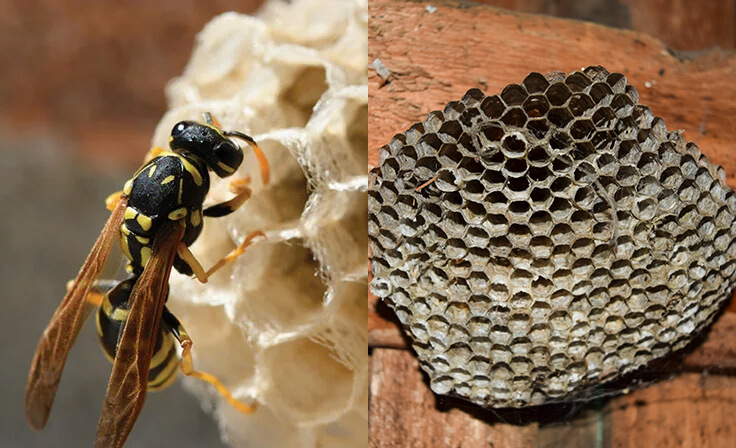
While they look remarkably similar, you can distinguish a European Paper Wasp by its antennae. European Paper Wasps have orange-tipped antennae, whereas Yellow Jackets have completely black antennae. Additionally, paper wasps tend to be slightly more slender and fly with their long legs hanging down, while yellow jackets tuck their legs against their bodies during flight.
European Paper Wasps build open, umbrella-shaped nests where you can clearly see the hexagonal cells from below. Unlike yellow jackets or bald-faced hornets that cover their nests in a gray paper envelope, a paper wasp nest is exposed. You will often find these attached to:
These wasps are generally considered semi-social and less aggressive than yellow jackets. They typically will not attack unless you are very close to their nest. However, because they often build nests in high-traffic areas like doorways and decks, accidental encounters are common in Wisconsin homes.
Yes, they can sting repeatedly if they feel their colony is threatened. The sting is painful and causes localized swelling or redness. While they are not as quick to swarm as yellow jackets, they will defend their nest vigorously if you attempt to knock it down.
The European Paper Wasp is an invasive species that has become dominant in Southeastern Wisconsin. They wake up earlier in the spring than many native species, allowing them to claim the best nesting sites and outcompete native wasps for food.
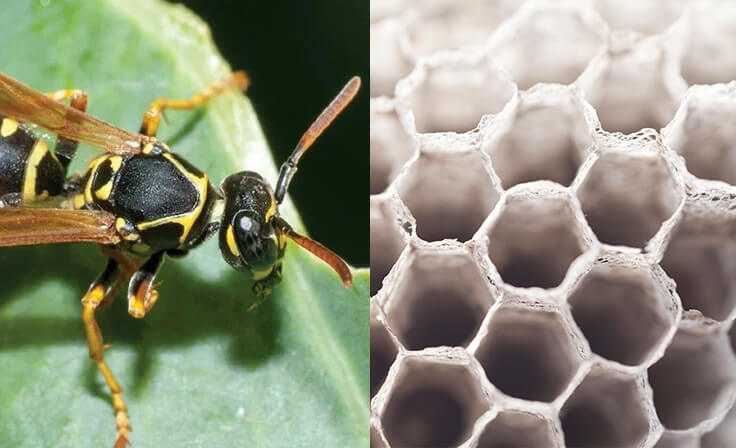
You can distinguish a paper wasp (genus Polistes) from other stinging insects by its flight behavior and body shape. They have slender bodies about 3/4" long and fly with their long legs dangling noticeably below them. Unlike the stout, fuzzy bumblebee or the compact yellow jacket, paper wasps have a distinct, pinched waist and a longer, narrower appearance.
Paper wasps seek out sheltered locations that are protected from the rain but open to the air. In Southeastern Wisconsin, their open-comb, umbrella-shaped nests are most commonly found in:
Paper wasps are generally less aggressive than yellow jackets but will sting if they feel their nest is threatened. Because they often build nests in high-traffic areas like doorframes or grill covers, accidental disturbances are common. They can sting repeatedly, which makes professional removal necessary if the nest is close to human activity.
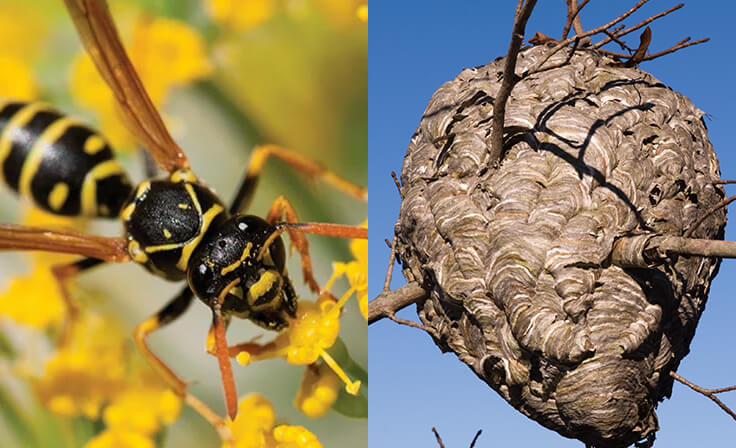
German Yellow Jackets are aggressive social wasps often mistaken for bees due to their black and yellow markings. Unlike a honeybee which stings once and dies, a yellow jacket possesses a smooth stinger that allows it to sting repeatedly. These pests are highly territorial and will defend their colony aggressively if disturbed.
Yellow jackets build distinctive nests using gray paper they create by chewing on tiny slivers of wood. The appearance and location depend on the specific species found in Wisconsin:
Homeowners often realize they have an infestation when they hear strange noises coming from a wall or ceiling. Listen for a distinct crackling or scratching sound. This noise is actually the sound of the colony chewing through drywall and wood to expand the nest.
If you suspect a nest inside the home, do not attempt to locate it by breaking through the wall. Instead, observe the exterior of the house to find where the wasps enter and exit through small cracks or crevices.
Yellow jacket colonies are annual and reach their peak size in late summer and early fall. This is when the population is highest and the wasps become most aggressive while scavenging for food. The colony will naturally die off when the hard frost hits Southeastern Wisconsin, leaving only new queens to overwinter and start fresh colonies in the spring.
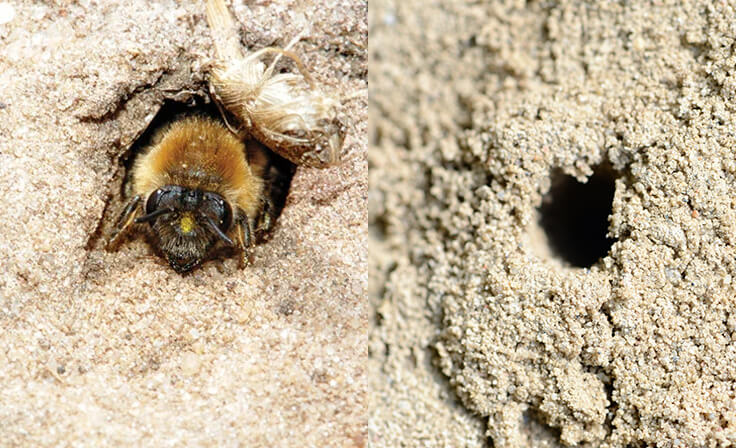
Mining bees (Andrena) are often the first sign of spring in Southeastern Wisconsin. These fuzzy, solitary bees typically emerge in March or April just as the ground begins to thaw. While their sudden appearance in large numbers can alarm homeowners, they are beneficial pollinators and behave quite differently from the aggressive wasps that appear later in the season.
You can easily distinguish mining bee activity from other pests by looking at the ground. Their nests have specific characteristics that appear in areas with exposed, well-drained soil or patchy grass:
Mining bees are not aggressive and rarely sting. Unlike social honeybees or yellow jackets that swarm to defend a colony, mining bees are solitary insects. Each female builds her own nest and has no collective hive to protect, so they remain very docile around humans and pets.
During mating season in early spring, male mining bees often fly low over the ground in search of females. This activity can look like a scary swarm, but the males cannot sting. This frenzy is temporary and usually subsides within a few weeks as the females retreat underground to lay eggs.
Extermination is rarely necessary. Mining bees are crucial early-season pollinators for Wisconsin flowers and fruit trees. They do not damage turf roots or kill the grass, and their activity lasts only a short time.
If the nesting mounds are a nuisance, the most effective deterrent is to run a sprinkler over the affected area. Mining bees prefer dry, sandy soil for digging. Keeping the lawn watered makes the soil too heavy for them to tunnel effectively and encourages them to nest elsewhere.
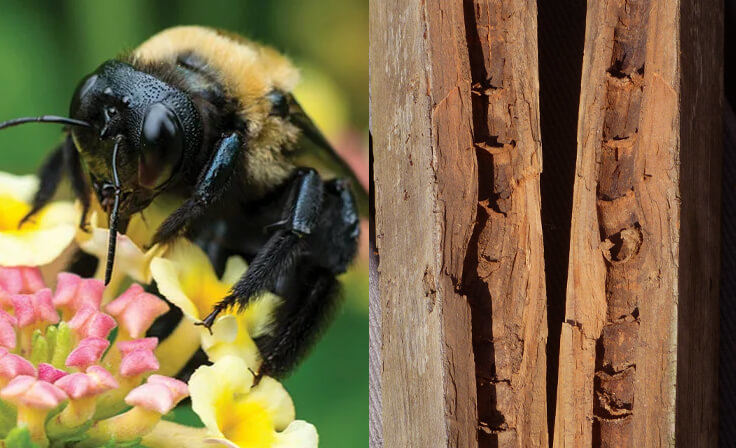
In the late spring and early summer, homeowners often notice large, black bees hovering around the outside of their homes. These are probably Carpenter Bees searching for mates and favorable sites to construct their nests. Male carpenter bees are quite aggressive, often hovering in front of people who are around the nests. The males are harmless because they lack stingers. Female carpenter bees can inflict a painful sting but seldom will unless they are handled or provoked.
Carpenter bees resemble bumblebees, but the upper surface of their abdomen is bare and shiny black. Bumblebees have a hairy abdomen with some yellow markings. Carpenter Bees can be found under eaves, decks, breezeways, etc. They drill holes in the exterior of the wood to lay eggs.
We do not exterminate carpenter bees.
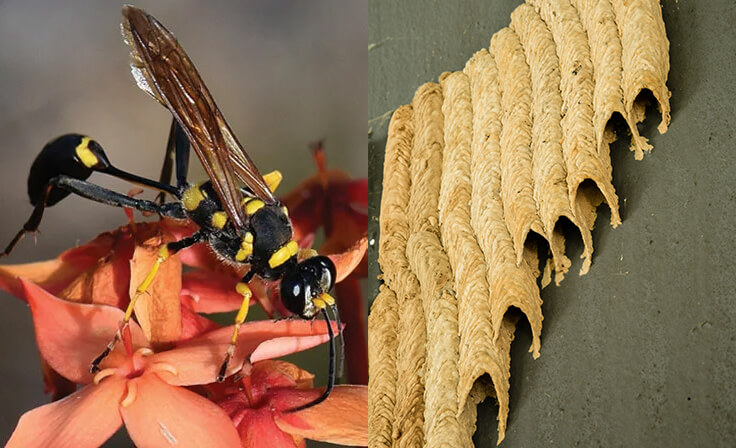
Mud daubers, found throughout Southeastern Wisconsin, are solitary wasps and are rarely aggressive toward humans. Unlike yellow jackets or paper wasps that defend a colony, a mud dauber builds a nest for itself and its offspring. They generally will not sting unless you directly handle them or threaten their nest.
These wasps are easy to identify by their long, thread-like waist that connects the thorax and abdomen. In Wisconsin, you will typically see the Black and Yellow Mud Dauber or the Metallic Blue Mud Dauber. They are slender and appear much longer than standard bees or wasps.
If you see tubes of dried mud on your brick, siding or eaves, you likely have mud daubers. They collect wet soil to construct organ-pipe style nests in sheltered areas. You will often find these nests in:
Yes, mud daubers can sting, and their venom is painful. However, they are not prone to stinging. Most stings occur when a homeowner accidentally grabs one or presses against one while working outdoors. Because they are solitary, you do not need to worry about a swarm attacking you.
Many Wisconsin residents refer to these insects as "mud bees" because of their nests. True bees usually nest in wax combs or wood tunnels, while mud daubers are the only large wasps in our region that construct homes entirely out of mud.
While they are beneficial for controlling spider populations, their nests can be an eyesore and messy. If a nest is located near a high-traffic doorway or inside a garage where you work frequently, professional removal is the best option to avoid accidental contact.
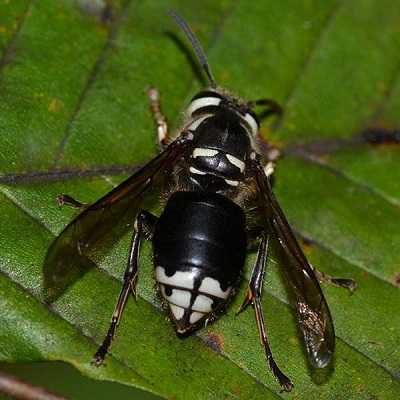
Bald-face hornets are certainly the strongest stinging insect I encounter on the job. They are the only ones able to sting directly through my protective clothing. They can even shoot venom into my eyes if they make it past the protective netting covering my face.
Hornets nests are entirely exterior -- trees, shrubs, under decks, and high in the eaves. They construct a "football" or upside-down teardrop-shaped nest from gray paper. Hornets, as do wasps and yellow jackets, make this paper themselves by chewing on tiny slivers of wood. The young are hatched and food is stored in the center of the nests' hexagonal cells. Hornet nests contain thousands of insects that are extremely aggressive when disturbed. The nests are often located out of reach and removal is best accomplished by a professional pest control firm. Unlike Bees, they can sting repeatedly. They build colonies annually.
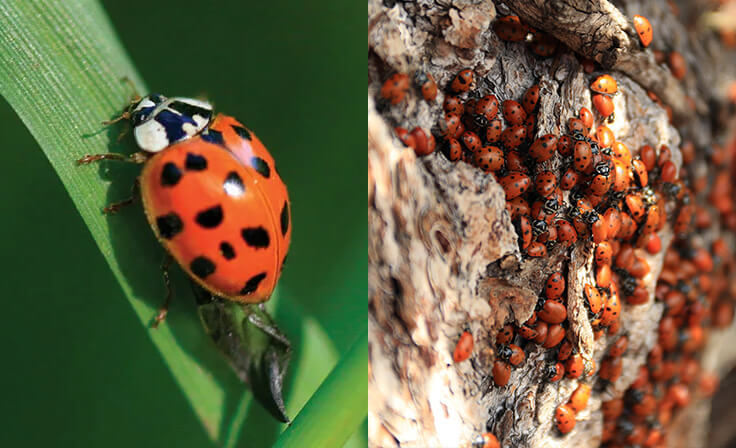
Preparation is key when it comes to Asian beetles. A properly timed exterior insecticide treatment can eliminate any infestations. Once the insects are in the house all you can do is vacuum them up. Never spray insecticides inside the house because they do not reproduce once inside.
During late winter or early spring, barrier treatments are ineffective because the beetles gained entry the previous autumn. Consider treatment before this happens.
To be effective, barrier treatments should be applied before the beetles enter buildings over winter. In Wisconsin, the proper timing for such treatments is early September thru the end of October.
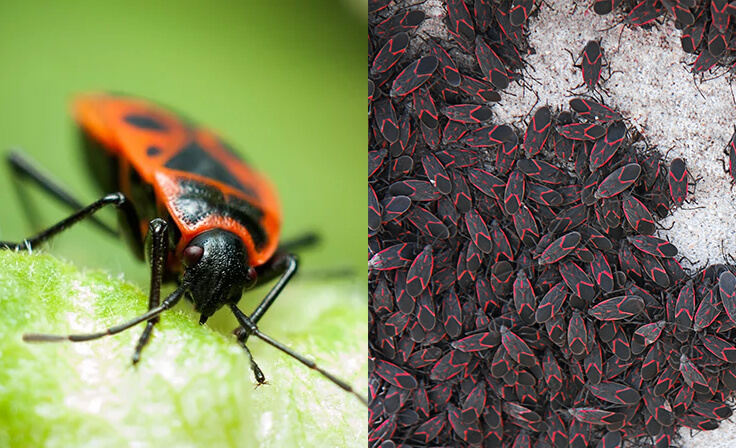
Boxelder bugs are a predictable part of autumn in Southeastern Wisconsin. As temperatures drop in cities like Milwaukee and Waukesha, these pests leave their host trees to seek warmth, often turning the sunny sides of homes into gathering spots. While harmless, their sheer numbers make them a significant nuisance during the fall migration.
These insects are easily identified by their black bodies with distinct reddish-orange lines forming a 'V' shape on their backs. They are roughly 1/2 inch long and have an oval, flattened body. You will typically find them clustering near boxelder, maple and ash trees during the summer before they move to structures in the fall.
Boxelder bugs gather on south and west-facing walls to absorb heat from the afternoon sun. They are looking for a warm place to survive the freezing Wisconsin winter. Once they warm up, they seek out cracks in siding, gaps around windows and vents to enter wall voids and attics where they hibernate.
If they are already inside, the most effective removal method is vacuuming. Suck them up with a hose attachment and immediately dispose of the bag in an outside trash bin. Avoid squashing them, as their body fluids can stain fabrics and walls.
Prevention is the only long-term solution. A professional barrier treatment applied to the exterior of the home from late September through October stops them before they enter. Once the frost hits and they are settled inside your walls, they are difficult to remove until they emerge in spring.
Strong scents like mint, clove and lavender naturally repel these insects from potential entry points. Additionally, spraying a simple solution of dish soap and water around window sills or door thresholds adds another layer of defense against minor infestations.
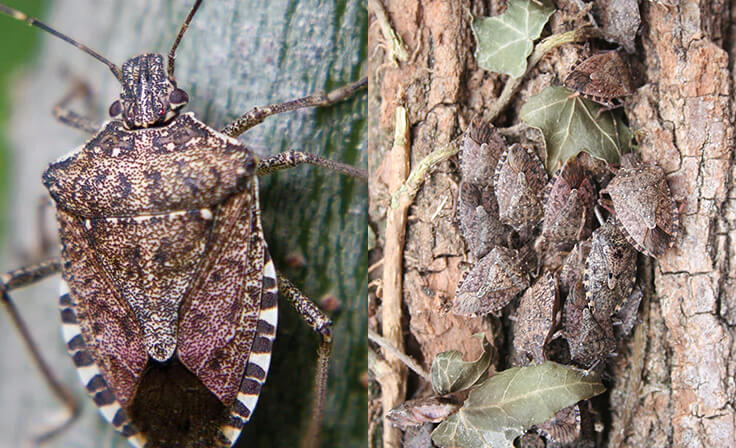
When disturbed or crushed, the brown marmorated stink bug releases a pungent chemical odor. This smell is often compared to rotting almonds, cilantro or burning tires. They use this scent as a defense mechanism against predators, which is why crushing them inside your home is not recommended.
Stink bugs enter homes in the fall to survive the freezing Wisconsin winter. You will often see them congregating on sunny exterior walls in September and October. They seek out cracks, gaps and crevices to move into attics and wall voids where they stay dormant until spring.
If they are already inside, the best way to remove stink bugs is to vacuum them up. Dispose of the vacuum bag immediately in an outdoor trash bin to keep the odor out of your living areas. Avoid squashing them, as this releases their foul scent and can stain surfaces.
The most effective time for professional stink bug control is late September through October. An exterior barrier treatment during this window prevents them from entering the home before they settle in for winter. Once they are inside the walls, they are difficult to remove until they emerge in spring.
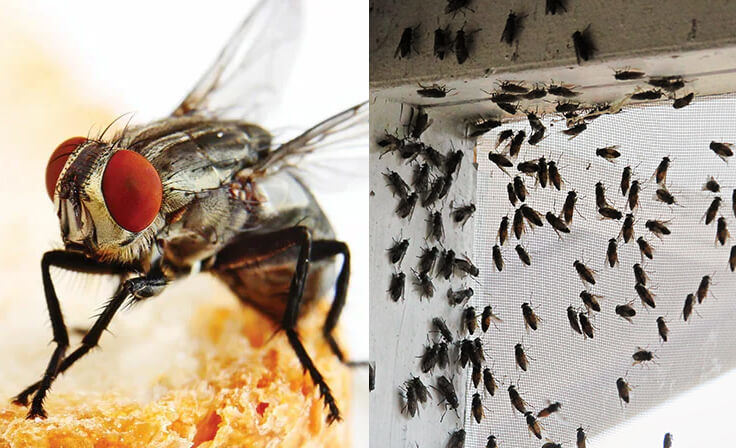
The Cluster Fly is a parasite of earthworms and breeds outdoors in lawns and fields during the spring and summer. You can find cluster flies almost everywhere in the United States and Canada, except for the Southern states bordering the Gulf of Mexico. When fall approaches, the cluster flies begin to enter structures in large numbers. Problems with cluster flies begin in late August as they begin to seek shelter for winter. The cluster fly is seeking warm sites with protective cracks for shelter, crawling back as far as they can get. It is important to consider treatment before this happens.
To be effective, barrier treatments should be applied before the flies enter buildings over winter. In Wisconsin, the proper timing for such treatments is typically late-September thru the end of October although this will vary with seasonal conditions.

Honey bees may establish a nest inside the wall of the house or other buildings causing a problem, a health hazard and a serious danger to the structure. Honey bees can only sting once before dying, making them reluctant to sting unless attacked.
Honey bee colonies in walls or attic voids are a more serious problem than yellowjacket wasps. Yellowjacket colonies are annual and the wasps will disappear in the winter with or without treatment. Honey bee nests may last for many years without treatment and will contain honey stored inside the walls. The honey can ruin walls and ceilings if not removed.
Combs inside buildings can also attract other bees and pests in the future. Controlling honey bee nests can be challenging. Call a pest control specialist if you spot bees around or coming out of your home.
We do not exterminate honey bees.

Bumblebees are social insects that live in colonies. Each spring a queen that has survived winter will find a suitable nesting site and establish her colony.
The bumblebee colony grows larger over the summer and is usually discovered while gardening or mowing the lawn. The bumblebees will attack to defend their nest, making them a health concern. They are pollinators and should only be exterminated if in an undesirable location. Unfortunately, they often build their nests under concrete by patios and steps. In that case, extermination is the only option. Bumble Bees are reluctant to sting, however, they will vigorously defend their nest.
Often confused with carpenter bees, bumblebees are characterized by the hairiness of the abdomen (carpenter bees have a smooth abdomen).
We do not exterminate bumblebees.


